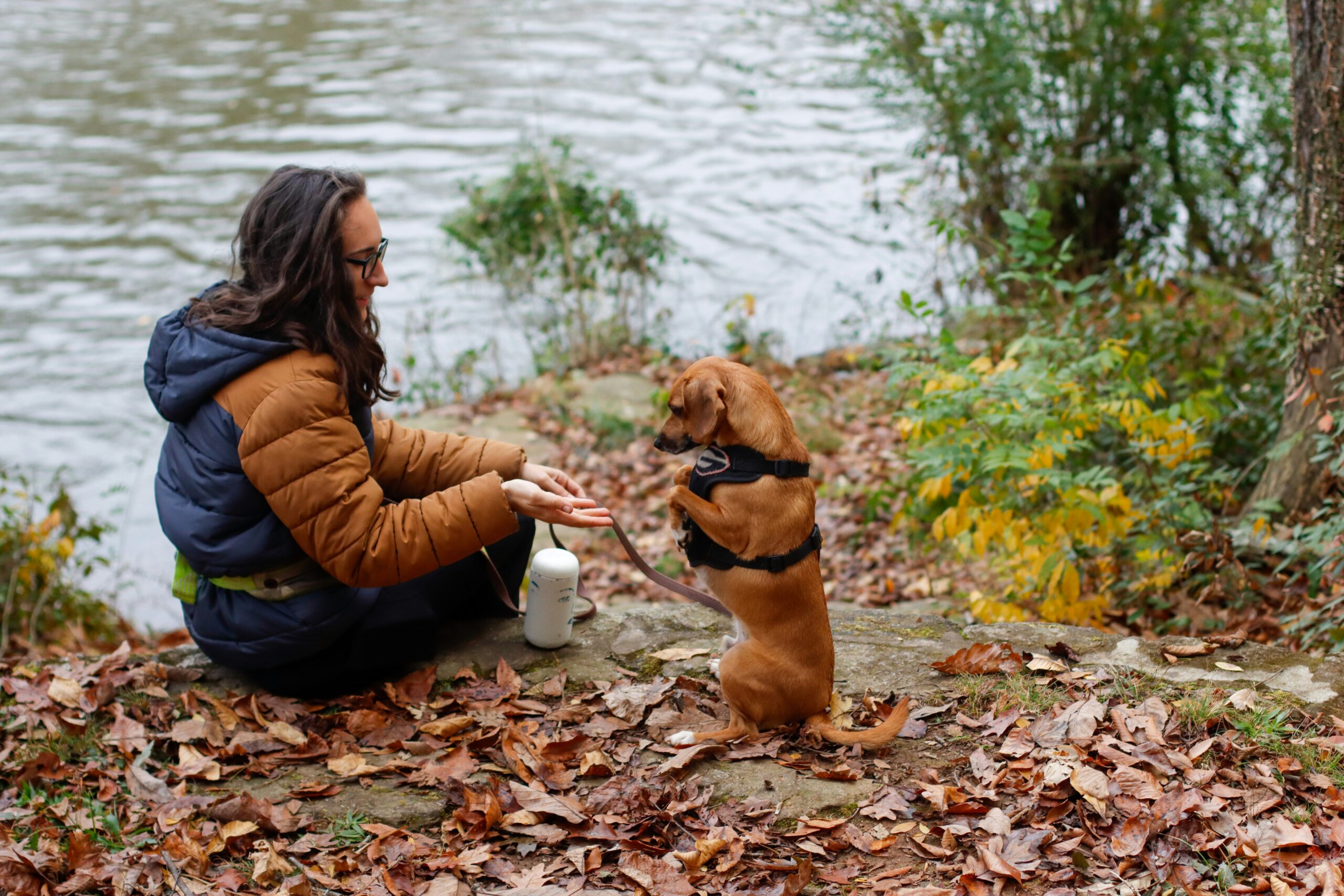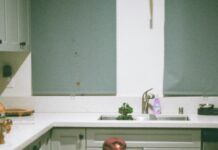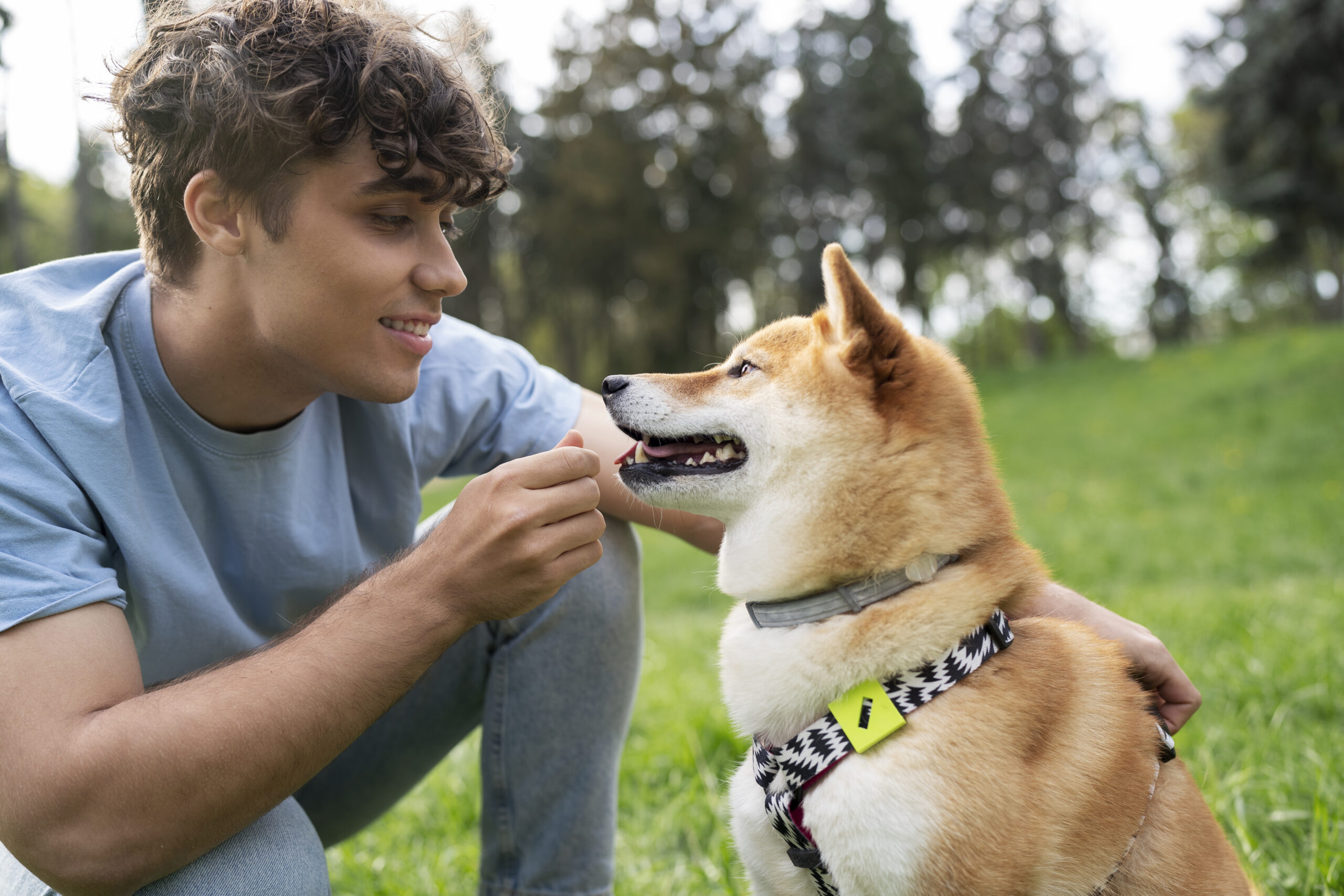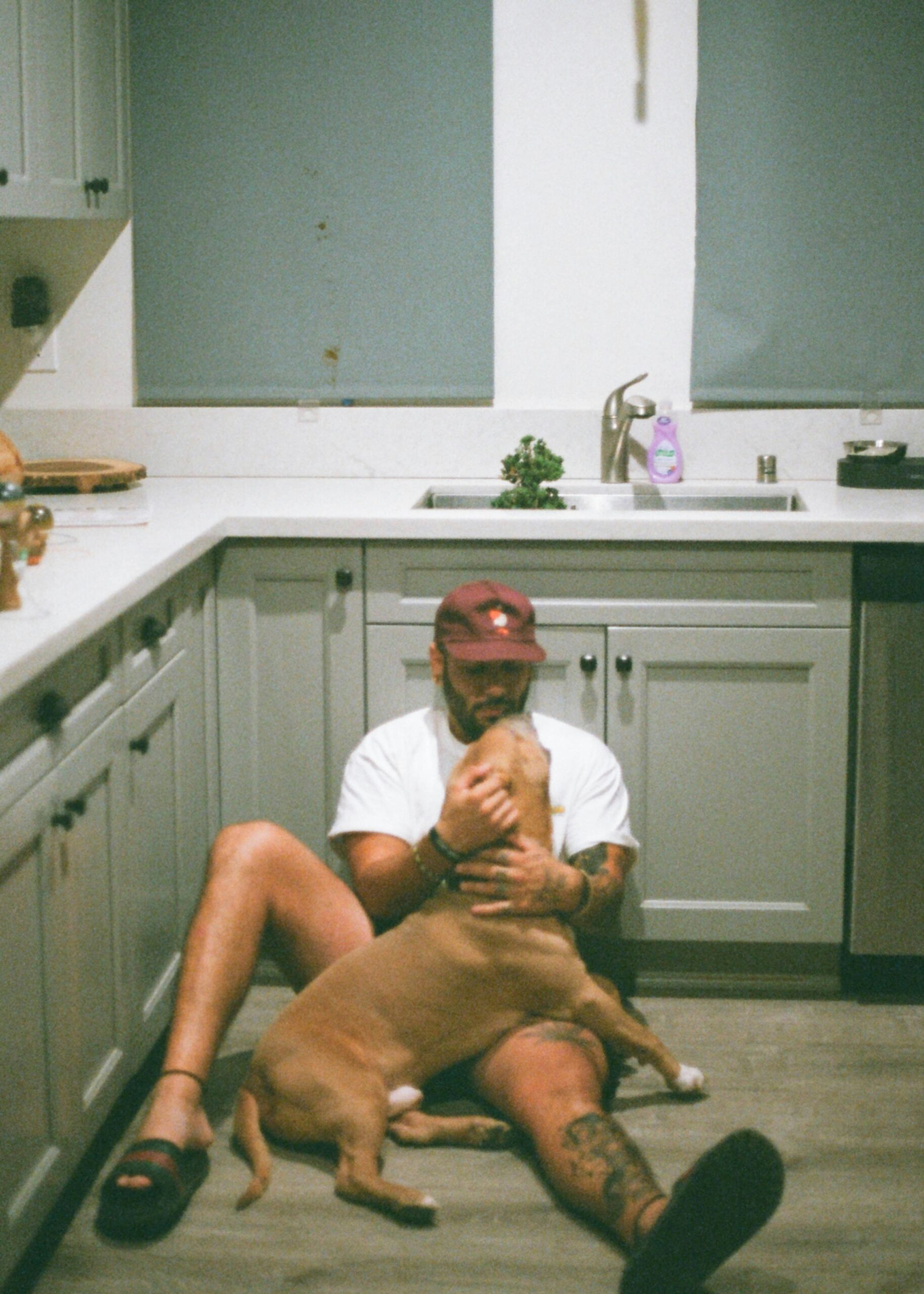Feeling overwhelmed by your new puppy? If you’re tired of sleepless nights filled with whining, constant battles with sharp puppy teeth, and endless clean-ups, you’re not alone. Bringing a puppy home is exciting, but the reality can be chaotic. This guide is different. It’s a single, comprehensive blueprint drawing on proven positive reinforcement techniques and expert-vetted schedules. We’ve compiled a practical, week-by-week plan to help you navigate the critical first 16 weeks with confidence. Forget scattered advice. This is your definitive resource to solve urgent problems like night whining and potty accidents before they become ingrained habits, and build a foundation for a well-behaved, happy companion. This is the only puppy training guide you’ll need, providing a clear puppy training schedule to follow from day one.
Table of Contents
- Foundations for Success: Setting Up Your Puppy’s World
- The 16-Week Blueprint: Your Step-by-Step Training Plan
- Urgent Problem Solvers: Real-World Scenarios & Solutions
- Expert Insights on Critical Puppy Topics
- What’s Next? Life Beyond 16 Weeks
- Conclusion
- FAQ
Foundations for Success: Setting Up Your Puppy’s World
Before you teach the first “Sit,” you must set the stage for success. Creating the right environment and adopting the proper training philosophy are non-negotiable foundations. This preparation will make the entire 16-week plan smoother and more effective, building a relationship based on trust, not fear.
The Power of Positive Reinforcement
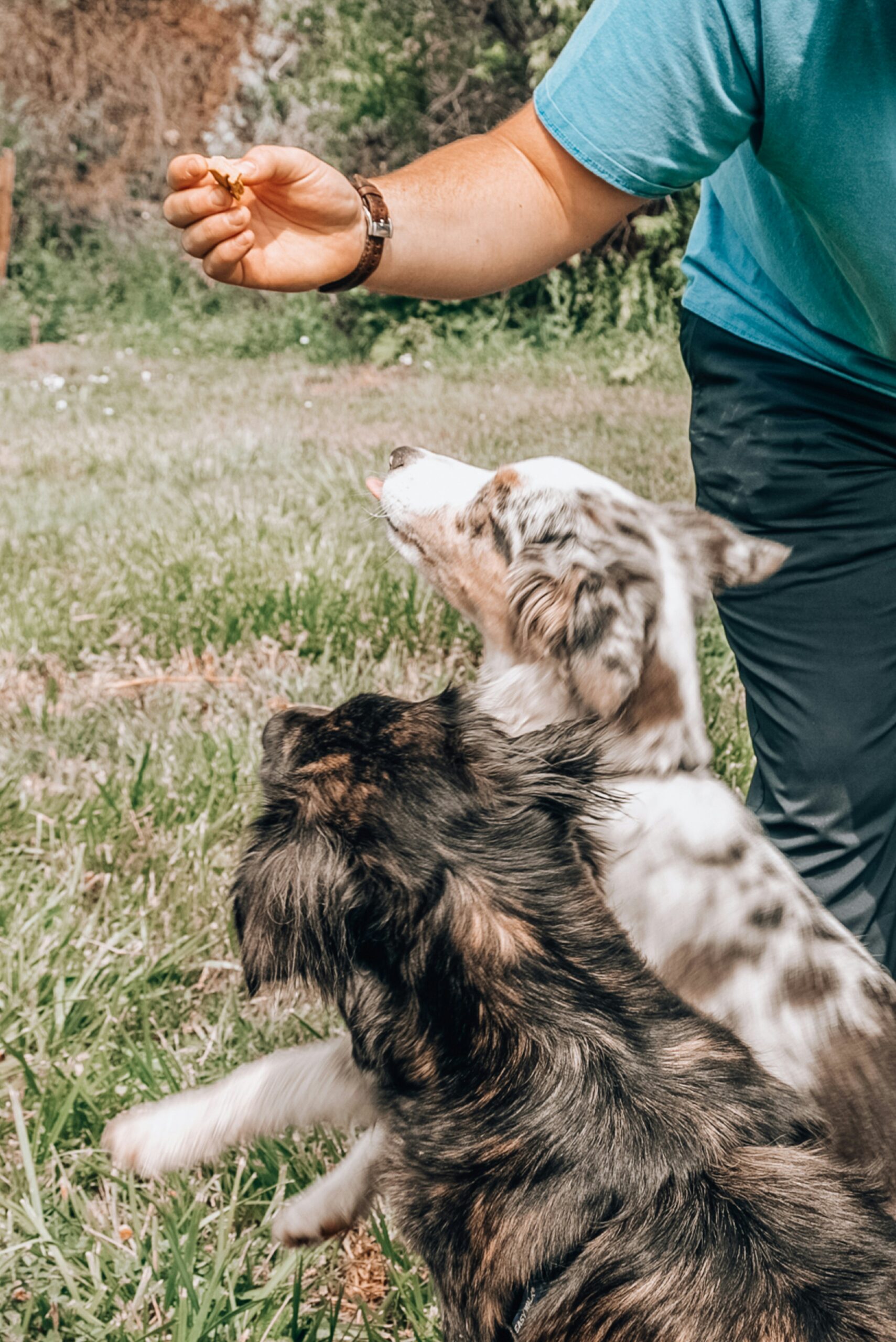
The most effective and humane way to train a puppy is through positive reinforcement. This method focuses on rewarding your puppy for behaviours you want to see, rather than punishing them for behaviours you don’t. When your puppy does something right—like sitting calmly or going potty outside—you immediately reward them with something they value, such as a small treat, praise, or a favourite toy. This creates a positive association with the desired action, making them more likely to repeat it.
According to the Napa Humane Society, this approach builds a strong bond and fosters a love of learning. Unlike punishment-based methods, which can create fear and anxiety, positive reinforcement training teaches your puppy what to do, not just what to avoid. These foundational puppy training tips are the bedrock of our entire schedule.
Creating a Rock-Solid Daily Schedule
Puppies thrive on predictability. A consistent daily puppy schedule helps them feel secure, understand expectations, and makes potty and crate training significantly easier. Your schedule should map out every part of their day: waking up, potty breaks, meals, training sessions, playtime, and naps. A new puppy checklist should always include a structured daily plan.
Consistency is key. A puppy’s bladder and digestive system are still developing, so scheduled potty breaks are essential. Scheduled nap times in their crate help prevent them from becoming overtired and cranky, which often leads to unwanted behaviours like excessive biting and zoomies.
Sample Daily Puppy Schedule (8-12 Weeks Old)
| Time | Activity | Notes |
|---|---|---|
| 7:00 AM | Wake Up & Potty Break | Playtime / Socialisation / Training |
| 7:15 AM | Breakfast (in crate) | Helps create a positive association with the crate. |
| 7:45 AM | Potty Break | After eating, they’ll likely need to go again. |
| 8:00 – 9:00 AM | Playtime / Short Training Session (3-5 min) | Supervised play and a quick lesson on “Sit.” |
| 9:00 AM | Potty Break | Before napping. |
| 9:15 – 11:00 AM | Crate/Nap Time | Puppies need 18-20 hours of sleep a day. |
| 11:00 AM | Wake Up & Potty Break | Immediately upon waking. |
| 11:15 – 12:00 PM | Supervised Free Time | In a puppy-proofed area. |
| 12:00 PM | Lunch | |
| 12:30 PM | Potty Break | After lunch. |
| 1:00 – 3:00 PM | Crate/Nap Time | Enforced naps prevent overtiredness. |
| 3:00 PM | Wake Up & Potty Break | |
| 3:15 – 5:00 PM | Playtime / Socialization / Training | Active time. Introduce new sights and sounds safely. |
| 5:00 PM | Dinner | |
| 5:30 PM | Potty Break | After dinner. |
| 5:45 – 7:00 PM | Calm Down Time | Gentle play, chewing on a toy. |
| 7:00 PM | Potty Break | |
| 7:15 – 9:00 PM | Crate/Nap Time | Final nap before bedtime. |
| 9:00 PM | Last Potty Break | Make it boring—no play, just business. |
| 9:15 PM | Bedtime in Crate | |
| ~2:00 AM | Middle-of-the-Night Potty Break (if needed) | No talking or playing. Out to potty and right back in. |
The 16-Week Blueprint: Your Step-by-Step Training Plan
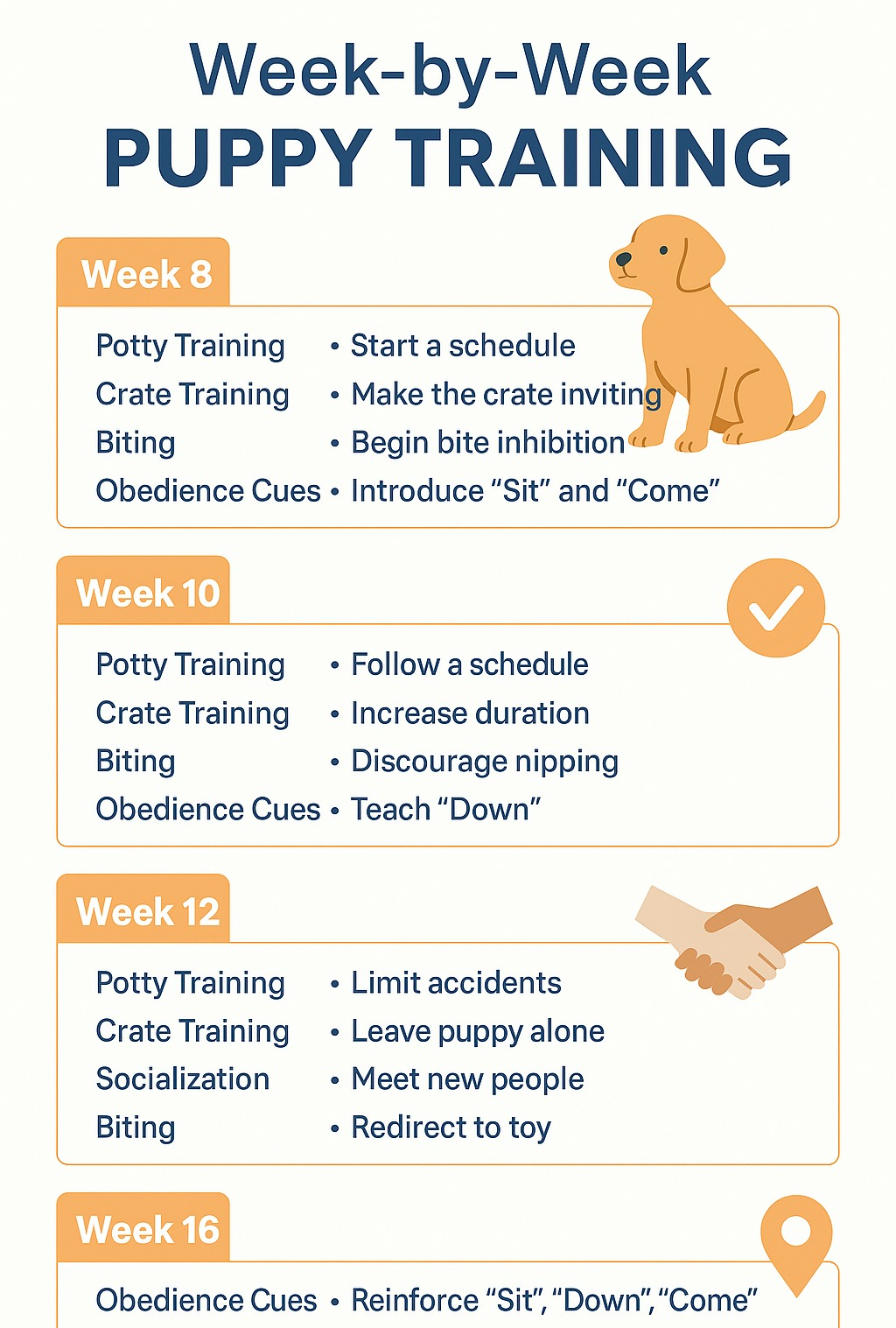
This is the heart of our guide: an integrated weekly plan that combines potty training, crate training, basic commands, and socialisation into one seamless schedule. Follow these steps to guide your new puppy through their most critical developmental period.
Weeks 8-10: Survival and Core Routines
The first few weeks are all about establishing foundational routines and surviving the initial adjustment period. Your primary focus should be house training and crate acclimation.
- House Training: Implement a strict potty training schedule for a 10-week-old puppy. Take them out first thing in the morning, last thing at night, after every meal, after every nap, and at least once every hour they are awake. Use a consistent potty spot and a verbal cue like “Go potty.” When they succeed, praise them lavishly and give them a high-value treat. Start a “potty log” to track their schedule and learn their patterns.
- Crate Training: The goal is to make the crate a safe, comfortable den, not a punishment. Introduce it slowly with treats and praise. Feed all meals in the crate with the door open.
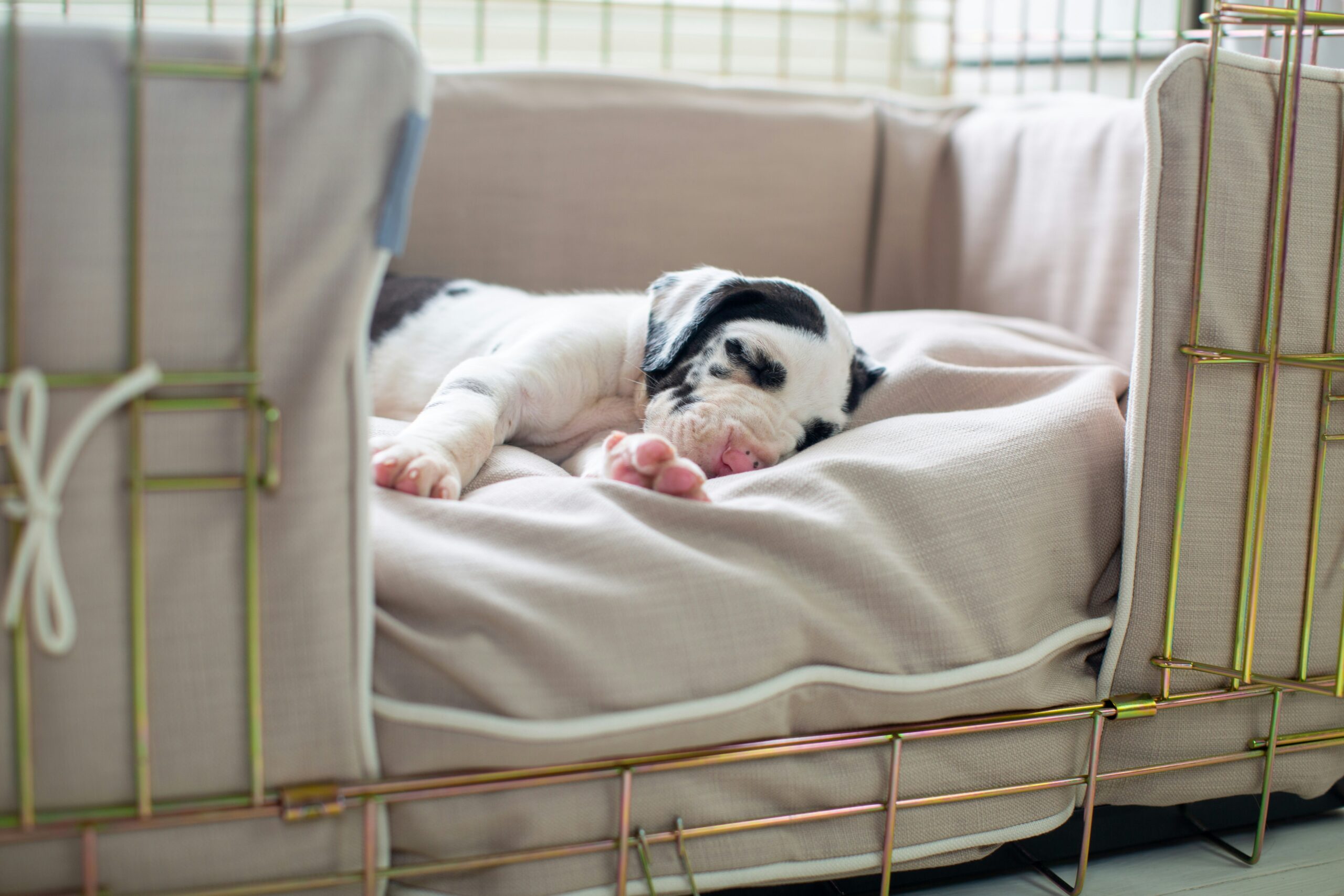
Begin a crate training schedule with very short, supervised sessions (a few minutes at a time) while you are home, gradually increasing the duration. At night, place the crate in your bedroom so your puppy doesn’t feel abandoned.
Weeks 11-13: Building Manners and Basic Commands
With routines taking hold, you can now focus on building good manners and introducing foundational obedience cues.
- Bite Inhibition: Puppies explore with their mouths. It’s your job to teach them how to be gentle. When your puppy nips too hard during play, let out a high-pitched “Ouch!” and briefly withdraw your hand. Redirect their mouth onto an appropriate chew toy. This is a crucial step to stop puppy biting hands.
- Basic Puppy Commands: Keep training sessions short and fun (3-5 minutes max). Start with the easiest commands:
- Sit: Hold a treat over their head and move it slightly back. As their nose goes up, their rear will go down. The moment they sit, say “Yes!” and give them the treat.
- Stay: Once “Sit” is reliable, ask them to sit, say “Stay,” hold up a hand, and take one step back. Step back to them immediately and reward them. Slowly increase the distance and duration.
Weeks 14-16: Socialization and Proofing Behaviors
Your puppy’s critical socialisation window is closing. Now is the time to broaden their experiences safely and make their commands reliable in different situations.
- Puppy Socialisation: Continue introducing your puppy to new sights, sounds, surfaces, and people in a positive and controlled way. This could include walking on different surfaces (grass, pavement, carpet), hearing the vacuum cleaner from a distance, or meeting new people who give them treats.
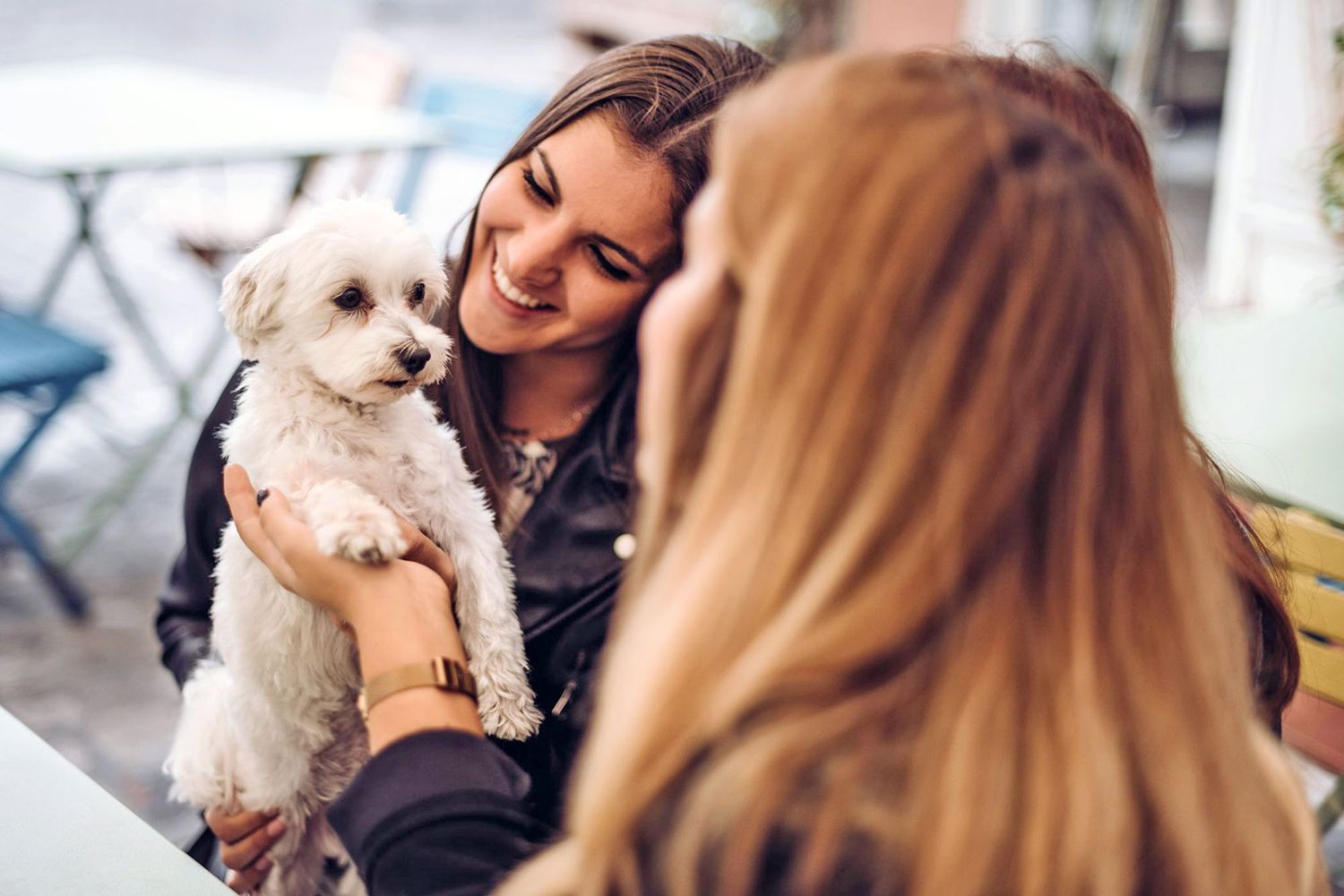
- Proofing Behaviours: “Proofing” means teaching your puppy to perform commands in various environments with distractions. Practice “Sit” in the living room, then the backyard, then on a quiet sidewalk. This generalises the command, so they learn “Sit” means sit everywhere, not just in the kitchen. This is the essence of effective puppy training.
Urgent Problem Solvers: Real-World Scenarios & Solutions
Even with the best schedule, problems will arise. Here’s how to troubleshoot the most common and stressful puppy issues.
Problem: My Puppy Won’t Stop Whining in the Crate at Night
Why it Happens: Your puppy is in a new environment, alone for the first time. The whining is a cry for comfort and security, not defiance. They are scared, not “bad.”
Step-by-Step Solution: Beagle puppy sitting attentively on grass, looking up at a treat in a person’s hand during a reward based training session.
- Make the Crate a Haven: Ensure the crate is cosy with a soft bed and a safe chew toy. Cover it with a blanket to create a den-like feel.
- Night One Plan: Place the crate right beside your bed where your puppy can see, smell, and hear you. If they whine, first wait a moment. If it continues, calmly place your fingers through the crate door. Don’t talk or make a fuss. Your presence is often enough.
- Potty vs. Attention: If it’s been several hours, it’s likely a legitimate potty need. Take them out calmly with no play or excitement, then place them directly back in the crate.
- Gradual Independence: Over several nights, as your puppy gets more comfortable, slowly move the crate further from your bed and eventually to its permanent location. This compassionate approach to crate training a puppy that cries builds trust. For more detailed strategies, many owners find success by following expert advice on solving common behaviour issues from reputable organisations.
Problem: My Puppy Keeps Biting My Hands and Feet!
Why it Happens: This is called mouthing or puppy nipping, and it’s a normal part of development. Puppies use their mouths to explore and learn. It’s different from true aggression, which is rare in young puppies. The goal is to teach bite inhibition—how to control the pressure of their jaw.
Step-by-Step Solution:
- Yelp and Withdraw: When your puppy’s teeth make contact with your skin, let out a sharp, high-pitched “Ouch!” or “Yip!” This mimics the sound their litter-mates would make. Immediately pull your hand away and ignore them for 15-30 seconds.
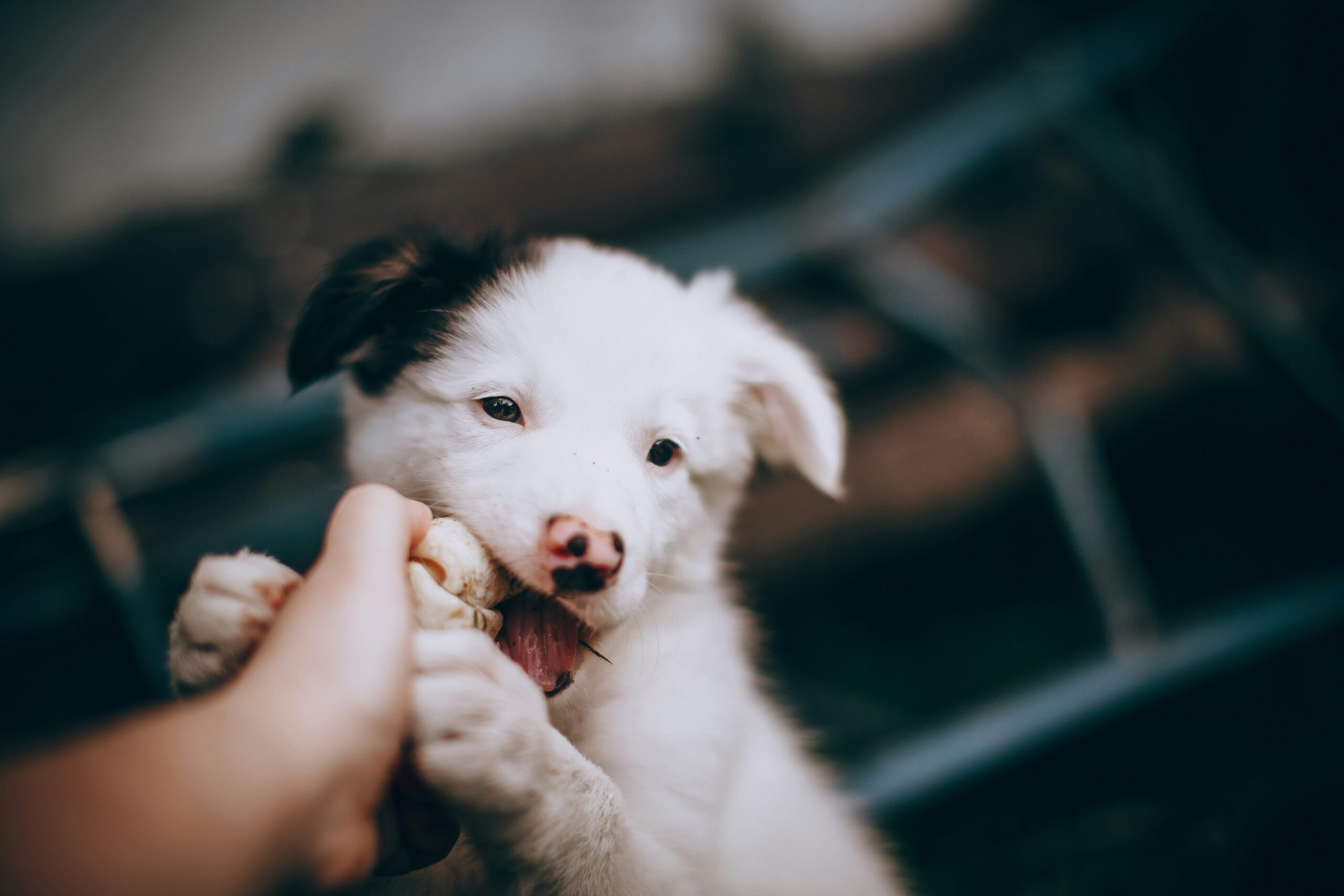
- Redirect to a Toy: Before the biting happens, or immediately after a “timeout,” offer an appropriate chew toy. Praise them for chewing on the toy. This teaches them, “Don’t chew this, chew that.”
- Reverse Timeout: If they persist, remove yourself. Calmly stand up and walk away for 30 seconds. This teaches them that biting makes their favourite playmate (you) disappear. These methods are key to stopping puppy biting hands.
Problem: My Potty Training Has Stalled or Regressed
Why it Happens: A puppy potty training regression is common and usually has a simple cause: too much freedom too soon, a change in schedule, or not cleaning up previous accidents thoroughly enough with an enzymatic cleaner (which eliminates scent cues)
Step-by-Step Solution:
- Rule Out Medical Issues: First, if the regression is sudden and severe, consult your vet. A urinary tract infection (UTI) can cause frequent, uncontrollable urination.
- Go Back to Basics: Revert to the strict schedule from weeks 8-10. Reduce their freedom and increase the frequency of potty breaks. Do not punish them for accidents; it only creates fear.
- Re-emphasise the Potty Log: Track their intake, output, and accident times. Look for patterns.
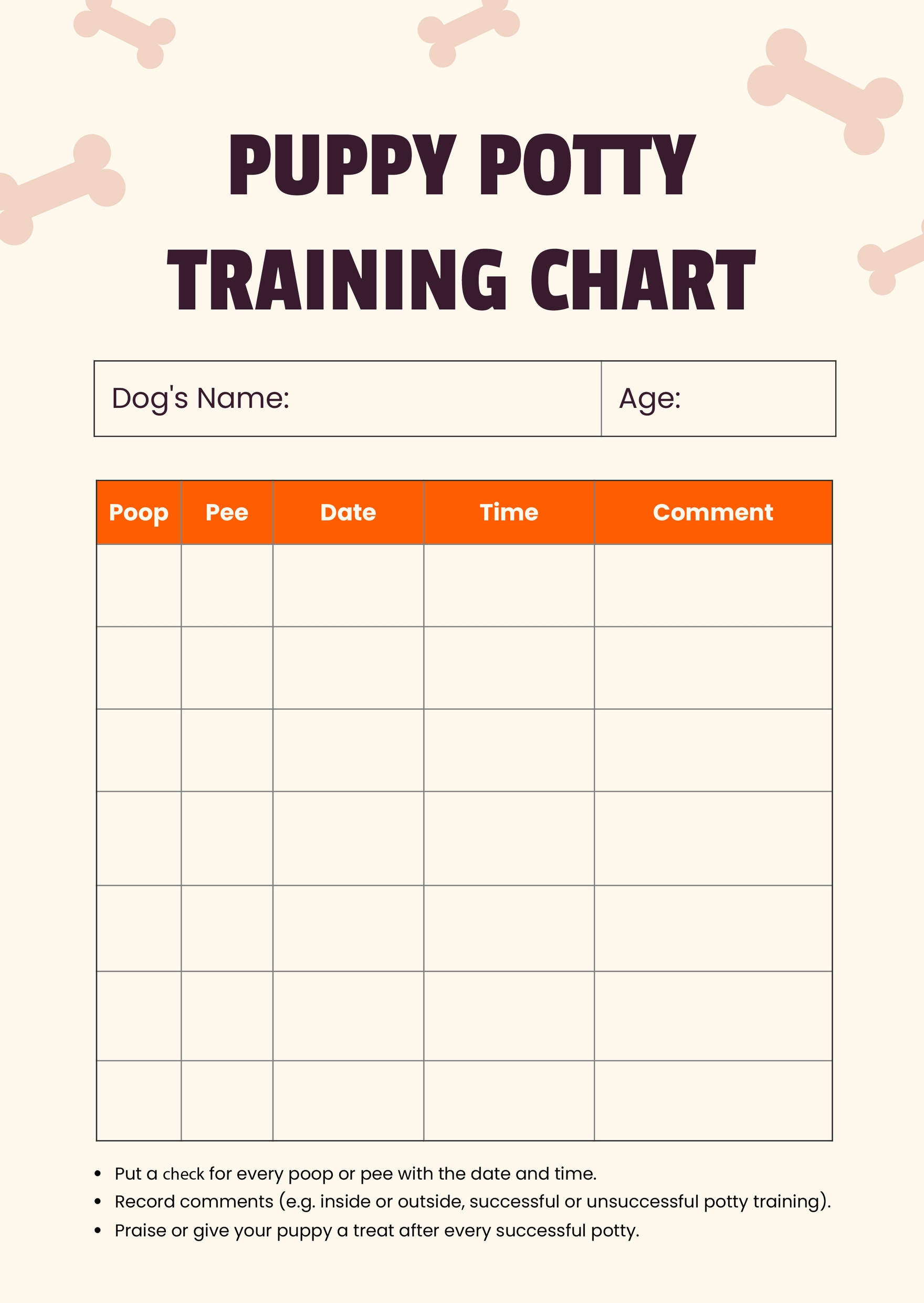
- Are accidents happening 30 minutes after eating? Set a timer and take them out at 25 minutes. Mastering how to potty train a puppy is about proactive management, not reactive punishment.
Expert Insights on Critical Puppy Topics Going beyond the basics, these expert-backed insights will help you navigate nuanced challenges with confidence. The Socialisation Window: Safely Exploring the World Before Full Vaccination. Many owners are afraid of puppy socialisation without vaccines, yet the critical socialisation window (3 to 16 weeks) closes long before they have full immunity. The risk of developing lifelong fear-based behavioural issues from a lack of socialisation is often higher than the risk of contracting an illness in a controlled environment. Experts agree that early, safe socialisation is paramount. According to the guidelines for proper puppy socialisation from The Ohio State University College of Veterinary Medicine, the goal is to create positive associations. A Puppy Socialisation Timeline from Texas A&M further emphasises starting these experiences early.
Safe activities include:
- Carrying your puppy through different environments.
- Sitting on a park bench and letting them watch the world go by from your lap.
- Visiting a friend’s home with a clean, private yard and a known, healthy, vaccinated adult dog.
- Attending a well-run puppy class requires proof of initial vaccinations.
Avoid dog parks and other areas frequented by unknown dogs until your vet gives the all-clear. These shy puppy socialisation techniques help build a confident, resilient dog. Training a Puppy with an Older Dog in the House. Introducing a puppy to a dog requires careful management to ensure a peaceful multi-dog household.
- Neutral Territory: The first meeting should happen in a neutral space, like a quiet street or park, not in your home, where the older dog may feel territorial.
- Separate Resources: To prevent resource guarding, give each dog their food bowls, water bowls, beds, and crates. Feed them separately.
- One-on-One Time: Ensure the older dog still gets plenty of individual attention and praise. When training a puppy with an older dog present, reward both dogs to create a positive association. The puppy’s arrival should predict good things for the resident dog.
- Supervise All Interactions: Never leave a new puppy and an older dog unattended until you are 100% certain of their relationship.
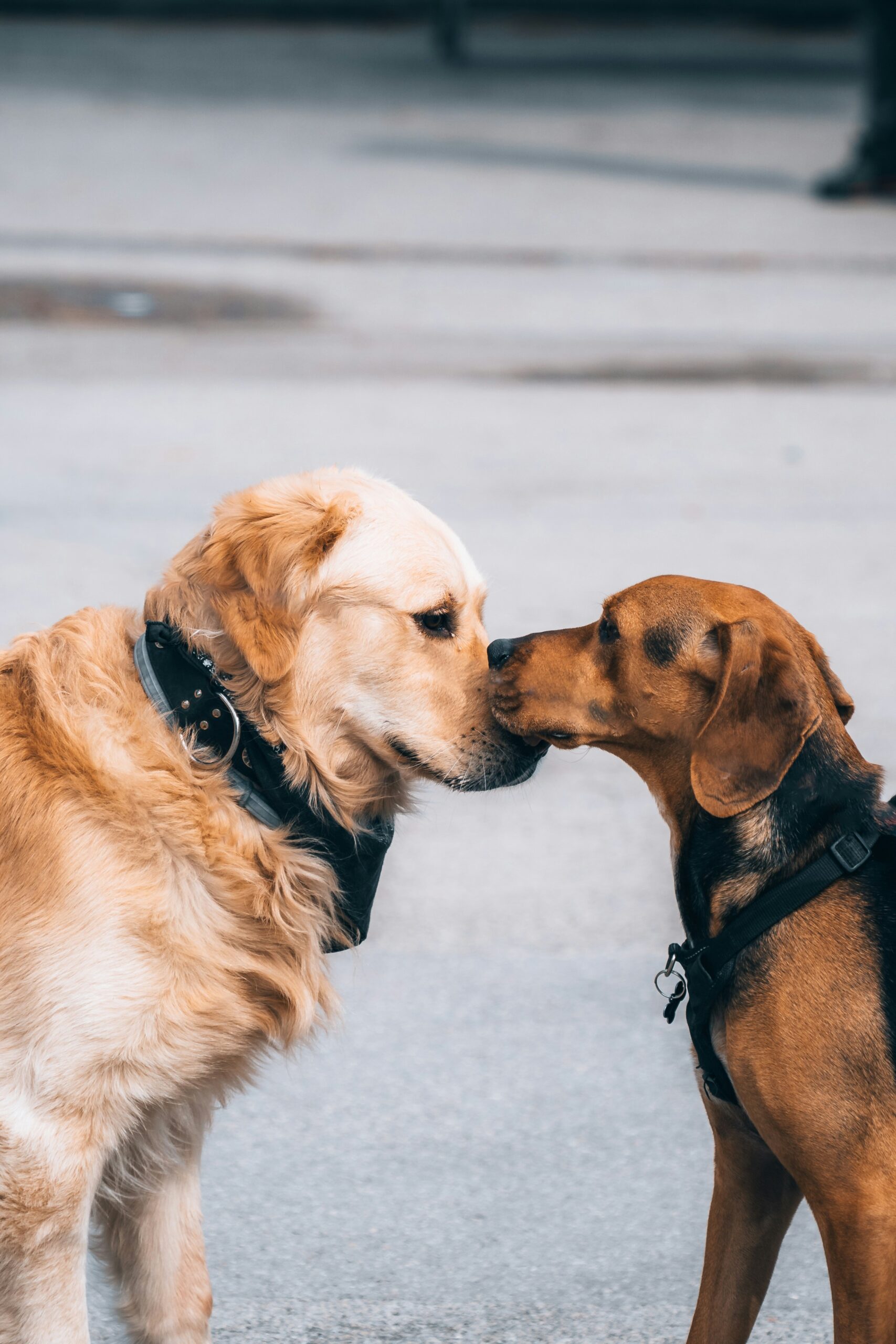
Understanding Your Puppy’s Short Attention Span. It can feel like your puppy is defiant when they lose focus after just a few minutes of training. This isn’t defiance; it’s biology. A puppy’s brain is still developing, and their ability to concentrate is extremely limited. Managing a puppy’s short attention span is about working with their brain, not against it.
- The 3-Minute Rule: Keep formal training sessions to just a few minutes at a time, multiple times a day. Three minutes of focused work is far more effective than one frustrating 15-minute session.
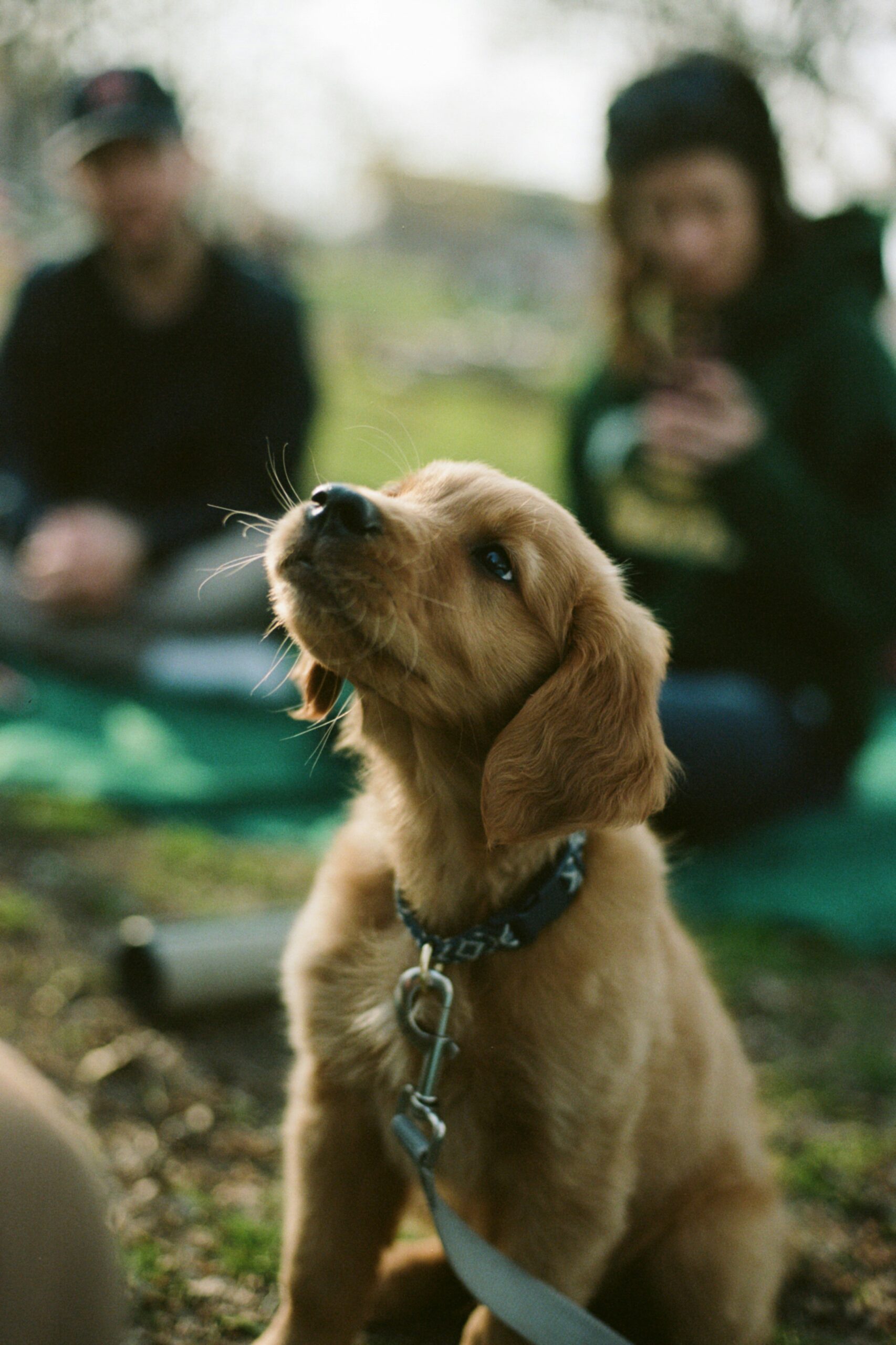
- Identify Fatigue: Signs of a mentally tired puppy include yawning, sniffing the ground excessively, scratching, or disengaging. These are cues to end the session on a positive note, not to push through.
- Make it a Game: Puppy training focus improves when it feels like play. Use an excited tone, quick movements, and frequent rewards to keep them engaged.
What’s Next?
Life Beyond 16 Weeks. Congratulations, you’ve survived the first four months! But the journey isn’t over. As you move beyond 16 weeks, you’ll enter the stage of puppy adolescence (typically 6-18 months). This period can bring new challenges, like boundary testing, a seeming “forgetting” of commands, and secondary fear periods. Consistency is your greatest tool. Continue to reinforce the rules and routines you’ve established. Ongoing dog training, whether through formal classes or daily practice at home, is essential for maintaining a well-behaved companion and strengthening your bond for years to come.
Conclusion
The first 16 weeks of a puppy’s life are a critical, formative window. While it can be a period of chaos and sleepless nights, it’s also an unparalleled opportunity to shape a confident, happy, and well-mannered companion. The key to success is not a magic wand, but a commitment to a consistent, positive, and schedule-based approach. By following this blueprint, you can effectively solve today’s urgent problems like biting and house soiling while building a loving, trusting bond that will last a lifetime.
FAQ
Q: How much do professional puppy training classes typically cost?
A: The puppy training classes cost varies widely by location and type. Group classes are typically more affordable, ranging from $150 to $300 for a 6-week course. They offer the benefit of socialisation with other puppies. Private, one-on-one training is more expensive, often costing $75 to $150 per hour, but provides personalised attention tailored to your puppy’s specific needs.
Q: What is the most effective way to teach a puppy the “Leave It” command?
A: The how to teach puppy leave it command is crucial for safety.
- Step 1: Place a low-value treat (like kibble) in your closed fist. Let your puppy sniff and lick your hand. The moment they pull their head away, even for a second, say “Yes!” and give them a high-value treat from your other hand.
- Step 2: Once they are reliably backing away from your closed fist, open your hand to reveal the kibble. When they move toward it, close your fist. When they back away, say “Yes!” and reward them on the other hand.
- Step 3: Now, place the low-value treat on the floor and cover it with your hand. When they back away, reward them.
- Step 4: Finally, place the treat on the floor uncovered. Say “Leave it” as they look at it. When they look back at you instead of taking the treat, reward them enthusiastically.
Q: My puppy’s behaviour seems extreme. When should I get professional help?
A: While most puppy behaviours are normal, some red flags warrant immediate professional intervention. These include true aggression (growling with stiff body language, snapping with intent to harm, not just mouthy play), extreme separation anxiety that doesn’t improve, or debilitating fear that prevents any socialisation. If you see these signs, it’s time to seek help. The ASPCA provides excellent guidance on finding professional behavioural help, such as a Certified Professional Dog Trainer (CPDT-KA) or a board-certified Veterinary Behaviourist.



